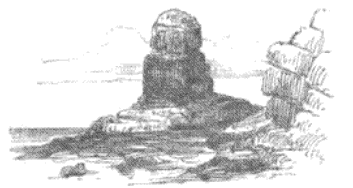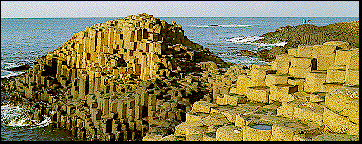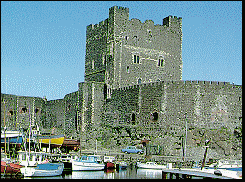Introduction: General Overview
The coast of Northern Ireland is the composition of approximately 40,000 huge columns of black basalt and some part of this creates a wide pavement of polygonal blocks going into the sea. The coast is named as Giant Causeway which is in county Antrim. In 1986 the World Heritage listed it under Natural Criteria VII and VIII. In 1987 the coast was announced as a national Nature Reserve. Its area is approximately 71 ha. The car park area, visitor facilities and hotel are included in this area. The national Trust manages the cliffs and foreshore and it is under the supervision of the Environment and Heritage Service of the Department of the Environment of the Northern Ireland. Many individuals own some sections of the cliff top parts as their private property (Giant’s Causeway and Causeway Coast Northern Island, United Kingdom, 2009).
There is a prodigy that the giant Fionn MacCumhaill built the Causeway to go the island of Staffa but the geographical evidence says that the Causeway is the result of the volcanic eruptions that happened sixty million years ago. The Giants Causeway becomes exceptional due to its geology. Because of its natural and geological significance, it has secured the place in UNESCO World Heritage site. According to a recent survey, it has been rated as more spectacular than the USA’s Grand Canyon or Peru’s Machu Picchu ruins (“When God made time He made plenty of it” they say here in Ireland,2009).
The Causeway is spread over 120 miles and its coastal route is considered to be one of the most pictographic in all Europe. It starts from Belfast and passes through Newtownabbey, gateway to county Antrim and then to the nine serene Antrim Glens: Glenarm (glen of the army); Glencloy (glen of the hedges), Glendun (glen of the brown river); Glentaisie (as in ‘Taisie’, princess of Rathlin Island)…and when you will reach the Causeway you would have already enjoyed the wonderful natural beauty, fishing villages, rugged cliffs and superb beaches (Giant’s Causeway and Causeway Coast Northern Island, United Kingdom, 2009).
The climate of the coast is governed by mild damp winds. The average temperature in December is 4.4° C and in July it becomes 14.4° C. Almost 200 plant species can be found here. They cover seashore, cliffs, grassland, scrub and marsh. Here over 50 resident and 30 migrant bird species are found (“When God made time He made plenty of it” they say here in Ireland, 2009).
Physical Features: Types of Rocks and their formation
From the past 300 years, this site has been studied well scientifically. In 1963 the origins of igneous rocks were first reported. In 1771, Desmarest declared that the Causeway was the result of lava flow. Hamilton also analyzed the Causeway in 1786. According to the perceptions and descriptions of Tomkeieff (1940) and Patterson (1955) for lava flows the Causeway is the description of columnar basalts (Giant’s Causeway and Causeway Coast Northern Island, United Kingdom, 2009).
The Causeway is the collection of basalt columns. The peaks of the columns create stepping stones that come from the cliff foot and vanish under the sea. There are approximately 40,000 stone columns mainly hexagonal but there are some eighth four, five, seven and eight sides. The highest is the 40 feet one and the thickness of lava in the cliffs is 90 feet (The Giant’s Causeway: Original Official Site of the Northern Ireland Tourist Board, 1997).

Between Causeway Head and Benbane Head, the total site is 5 kilometers long. The coastline of the Causeway consists of a series of 100m headland cliffs of regular pieces of lava. It makes the northern part of a plateau. The Giant’s Causeway is sea level pavement running beside the sea. It is the part of the approximately 40,000 polygonal pieces having the size of 45 cm in diameter that is formed by quick cooling of extruded lavas (“When God made time He made plenty of it” they say here in Ireland, 2009).
It is supposed to be an unparalleled display of geological formations which is the part of volcanic activity, happened 50-60 million years ago in Tertiary period. Almost 3,800 km of the Antrim Plateau is covered by the lavas and has become the largest remaining lava plateau in Europe. The cliffs of the edge of the Causeways are treaded because of continuous erosion of lava flows. They comprise of lower basalts in which 67m thick lava flows can be found. They are shown to Plaskin Head and Benbane Head; the interbasaltic beds are greatly shown to cliffs eastside of the Giant Causeway; the Middle Basalts range from 30m to 150m thick and create the cliffs on the site. The coastline is cut by olivine and tholeiite dykes: it is a very good example of Roveran Valley head where they can be seen. Staffa’s columned cliffs are very popular. Among the island of Western Scotland, columnar basalts are found in an isolated condition. The remote island of Canna has same features as Antrim (“When God made time He made plenty of it” they say here in Ireland, 2009).
The east part of the County Antrim has a basaltic plateau sloping from the heights of 300-450m near the coast. Under this coast there is an ancient beach that is lifted above sea level. The Antrim coast road follows it up to Cushendall. It consists of major Mesolithic remains. There are many deep glens coming from the coast and going into plateau and they end in the hills.Trostan that is 554m high and Slieveanorra that is 513m are the main highest summits of this plateau in the north, Knocklayd hill is situated behind the town of Ballycastle. Its basalt is covered with while chalk. The drainage from the valley of the River Main enters the north-east corner of Lough Neagh. In the South, the plateau looks like a steep face to the Lagan Valley where the black basalt excessively covered with chalk can be noticed. In contrast to North Antrim, the uplands here are covered with pastures (Theodore William Moody et al., 2005).
In the West of the Lower Bann the hills drop sharply and continue with the Sperrin mountains. South of this part again has a plateau which is developed on Old Red Sandstones. The acid nature of the rocks has created deep bogs. At the extreme south there is Clogher Valley that is moraine covered limestone-floored. Lough Neagh and the bann lowland absorb depression in the basalts.TheBann lowlands consist of glacial deposits, some of them form drumlins. There are sands and gravels which are good for agricultural activities. There is a flat floored valley about four miles wide stretching form south-east to the north-east. It is covered with glacial sands and gravels (Theodore William Moody et al., 2005).
The eastern coast of County Antrim has been raised by the old coast cliffs pierced through caves. Sea-stacks of rock stand straight and seem to be prominent monuments. One of these is situated above the harbour of Ballycastle and the other one is the east coast of Island Magee as shown in the following picture (Edward Hull, 2008).
These caves can be observed piercing through New Red Sandstone at Red Bay and basalt along the North coast of Larne. On the Antrim coast near Larne Harbour, the fabulous part of the raised beach-bed could be seen. it is open in some gravel pits. The sea bed is here elevated like a terrace which is about fifteen to twenty feet high and it could be noticed the composition of weatherworn gravel with many marine shells. These shells are of the species living in the neighboring sea and the flints are rude form known as ‘Paleolithic’ (Edward Hull, 2008).

Many old river terraces have also been observed but the most historical and architectural terrace is the terrace at the lower end of Glendalough. This terrace is formed of gravel of rounded pebbles and sand (Edward Hull, 2008).
The South line from Dublin to Galway Bay is made of substantial hill masses. Some of these hills formed due to folding which brought sandstones to surface, where rounded heather-covered slopes are created. Slieve Bernagh and Arra mountains are the part of it. Slievenamon, the Galtees and the Ballyhoura hills have the same structure and they belong to same age. There are other hills also which form low plateaus and they are different from the lowland due to their thin covering and acid, leached soils, blanket swamp and reedy fields. In North Clare the Carboniferous limestone misses Galway Bay. The limestone goes to the South and looks like a surface of Karst with the bare rock that forms well connected slabs without surface drainage. This limestone disappears under deposits of shale and grits towards the south in the Aran Island in the Galway and then the landscape changes drastically. Bare limestone form ill drained, reed covered fields and the plateau in the cliffs of Moher rise vertically from the sea and make a beautiful line of cliff scenery in Europe. These rocks vanish under the glacial deposits, thick alluvium and peat bogs while going towards the Shannon but they again can be seen in the South like the Mullaghareirks, a peat-covered plateau 420m high. Its scarped edges can be seen in Newcastle West that forms Limerick lowland (Theodore William Moody et al., 2005).
The other major plateau area that has same structure and composition can be noticed in the west of the Barrow in Carlow, Kilkenny and east Tipperary. It is high 300m in the northern part of the Castlecomer plateau. It is here coal-bearing (Theodore William Moody et al., 2005).
So basically the rocks here are made of lava, limestone, coal, basalt and chalk kind of substances and are formed by different activities of nature and geological formations like volcano activities.
Industrial Uses
At Kilroot on the north shore of Belfast Lough, a great quantity of shells and worked flints can be seen. The members of the Belfast Naturalist Club first discovered this ancient work. Later Mr. Du Noyer, who was having the arrowheads or spearheads, evaluated the good quantity of the chips of flint. He concluded that the shore of Kilroot had been an ancient Paleolithic workshop and with the help of chalk flints of the adjoining hills weapons of wars and the chase were made in the ancient time (Edward Hull, 2008).
In the North side of the Dublin-Galway line, there is some of the best agricultural land of the country. The coast has abundance of pastures and grasslands. The bedrock is full of thick morainic deposits originated from the essential limestone rock (Theodore William Moody et al., 2005).
The National Trust Management is managing the site’s natural quality for public access. It is maintaining public footpaths and also creating new ones. It is also conserving fauna and flora of this site. The Causeway is drawing approximately 400,000 visitors annually. It was heavily commercialized until 1961. That is why two hotels and many guesthouses were built. Many geology students and other school children come to see it every year (Giant’s Causeway and Causeway Coast Northern Island, United Kingdom, 2009).
Tourist Amenity
There is the early 17 Century Old Bushmills Distillery which is the World’s oldest distillery. At Bushmills there is a castle crowned rock that is called Dunluce Castle. Carrick-a-Rede Rope Bridge in the fishing village of Ballintoy shows some good scenery (“When God made time He made plenty of it” they say here in Ireland, 2009).

When Belfast was a sand bank Carrickfergus was a flourishing town (Carrickfergus Castle, Original Official Site of the Northern Ireland Tourist Board, 1997). In Carrickfergus one can see lots of things from medieval lanes to ancient walls. On a solid rock this castle and harbour was built. It became the symbol was power which protected the town that developed around it. At present this place is the most visited place among other tourist spots in this coast. Here almost ten thousand visitors come every year from ll over the world (Carrickfergus Borough, “When God made time He made plenty of it” they say here in Ireland, 2009).
This castle is a well preserved monument with lots of informative exhibitions. It also hosts weddings and medieval banquets. Its museum tells about the long history of the town. St Nicholas Church is the focal point of the town. It as built in the 10th century. Its architecture is very beautiful that contains stained glass. This church has unique crooked aisle, Chichester Memorial and Leper’s Window (Carrickfergus Borough, “When God made time He made plenty of it” they say here in Ireland, 2009).

The Maritime area consists of the modern 300 berth marina. It has been awarded by ‘Blue Flag’ as one of the prestigious place with world class amenities for visitors including disabled. It has the facilities like cafes, restaurants, apartments, scenic walkways and a cinema complex. This area has excellent marine services and it continuously host many prominent international sailing events which attracts visitors from all over the world (Carrickfergus Borough, “When God made time He made plenty of it” they say here in Ireland, 2009).
References
Giant’s Causeway and Causeway Coast Northern Island, United Kingdom, 2009. Web.
Hull, Edward, 2008, The Physical Geology a Geography of Ireland, Bibliolife, p. 312.
Moody, Theodore William et al., 2005, A New History of Ireland: Prehistoric and early Ireland, London, Oxford University Press, p. 1219.
The Giant’s Causeway: Original Official Site of the Northern Ireland Tourist Board, 1997.
When God made time He made plenty of it” they say here in Ireland, 2009. Web.